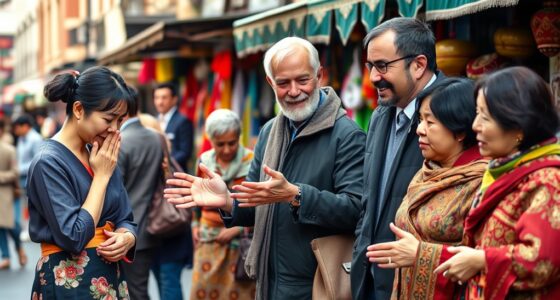In many cultures, love is expressed through meaningful gestures like bowing in Japan, touching the feet in India, or embracing and holding hands. Rituals such as wedding dances or exchanging symbolic gifts also symbolize affection and commitment without words. Jewelry or meaningful objects often serve as silent signs of love. These actions and symbols reflect deep cultural values and emotional bonds, showing that love is felt and shared through actions every day. Continue exploring to discover even more heartfelt expressions across cultures.
Key Takeaways
- Gestures like bowing in Japan express respect and affection without verbal communication.
- Touching or holding hands signifies love and closeness across many cultures without words.
- Rituals such as traditional dances or gift exchanges symbolize commitment and affection publicly.
- Symbols like jewelry or meaningful objects serve as silent representations of love and devotion.
- Cultural actions like touching the feet in India convey respect, devotion, and love nonverbally.

Have you ever wondered how people express love without uttering a single word? It’s fascinating to realize that love isn’t solely communicated through spoken language; instead, many cultures rely heavily on gestural expressions and cultural rituals to convey deep affection. These nonverbal cues often carry layers of meaning, reflecting shared history, beliefs, and social norms that transcend words. When you observe these gestures, you’ll notice they’re more than simple actions—they’re powerful symbols rooted in tradition and cultural identity.
In some cultures, a gentle touch or a specific hand gesture can speak volumes. For example, in Japan, bowing is a common way to show respect and affection, especially during moments of gratitude or love. The depth and duration of the bow can subtly indicate the strength of your feelings. Similarly, in India, touching the feet of an elder or a loved one is a sacred gesture that signifies respect, devotion, and love. These gestures aren’t just formalities—they’re culturally ingrained rituals that express heartfelt emotion without a single word spoken.
Across many African communities, physical closeness and specific gestures like embracing or holding hands serve as powerful signals of love and solidarity. These actions are often performed during ceremonies or daily interactions, reinforcing bonds within families and communities. In Greece, a simple gesture like placing a hand over the heart or giving a heartfelt hug can communicate deep love and affection, especially in intimate settings. These gestures often carry cultural significance, acting as silent vows of loyalty and care.
Cultural rituals also play a essential role in nonverbal expressions of love. In many societies, special ceremonies or traditional acts serve as public affirmations of affection. For example, some cultures have specific dances, rituals, or symbolic exchanges that encapsulate love’s meaning. You might see a traditional dance performed during a wedding that symbolizes union and devotion, or a ceremonial gift exchange that signifies commitment. These rituals are deeply embedded in cultural fabric, transforming personal feelings into shared community experiences.
Additionally, in some cultures, cultural symbols such as jewelry, clothing, or specific objects are used to convey love and commitment without words. You might see a bride wearing a particular piece of jewelry that symbolizes her love and fidelity, or a man presenting a meaningful gift that signifies his devotion. These symbols serve as tangible expressions of emotion, often carrying rich cultural significance that enhances their romantic meaning.
Ultimately, when you observe these gestural expressions and cultural rituals, you realize that love’s language is universal yet uniquely expressed by each culture. They remind you that love isn’t just spoken; it’s felt, demonstrated, and celebrated through actions that connect people across borders. Whether through a respectful bow, a loving embrace, or a symbolic ritual, these nonverbal ways of expressing love reveal the rich tapestry of human emotion that transcends language barriers.
Frequently Asked Questions
How Do Non-Verbal Cues Vary Across Cultures?
You’ll notice that non-verbal cues, or silent signals, vary widely across cultures. Cultural touchpoints influence how people express feelings without words, such as gestures, facial expressions, or eye contact. In some societies, a warm hug or prolonged eye contact shows affection, while in others, subtle nods or respectful distances convey the same message. Understanding these differences helps you interpret emotions accurately and navigate cross-cultural interactions smoothly.
Are There Universal Gestures for Expressing Love Silently?
Think of silent communication like a universal language, yet no single gesture symbolizes love across all cultures. Gesture symbolism varies widely, and what’s meaningful in one place might be confusing elsewhere. While some gestures, like a gentle touch or eye contact, often express affection, there’s no single universal gesture for love. Instead, you rely on context and cultural cues, making love’s silent language beautifully diverse worldwide.
How Do Children Learn to Express Love Non-Verbally?
You learn to express love non-verbally through gestural communication by observing and mimicking those around you. As a child, emotional bonding forms when you see gestures like hugging, holding hands, or gentle touches, which convey affection without words. These actions help you understand love’s silent language, allowing you to develop trust and connection. Over time, your own gestures become a natural way to show care and emotional intimacy.
Can Cultural Differences Lead to Misunderstandings in Expressing Love?
Think of love as a delicate dance; cultural differences can cause missteps if you’re unaware of local rhythms. You might misinterpret gestures due to cultural taboos or varying views on emotional privacy, leading to misunderstandings. What feels genuine in one culture may seem reserved or overly forward in another. To avoid this, learn the unspoken rules—they’re the silent language that keeps your connection harmonious across cultural boundaries.
What Role Does Body Language Play in Romantic Relationships Worldwide?
Body language plays a vital role in romantic relationships worldwide, serving as a universal language of emotional gestures. You can express love through cultural touchpoints like eye contact, touch, or posture, which often convey more than words. These non-verbal cues help you connect deeply, bridging cultural differences and enhancing intimacy. Paying attention to these signals guarantees you understand your partner’s feelings, fostering trust and strengthening your bond across diverse cultural backgrounds.
Conclusion
Now, you see how love transcends language, flowing through gestures, actions, and even the silent language of the heart—like a Morse code of emotions. Whether it’s a bow, a shared meal, or a simple touch, each culture teaches you that love doesn’t need translation. So, next time you want to say “I love you,” remember it’s more about the feeling behind the words—like a timeless vintage record playing love’s universal song across all boundaries.










